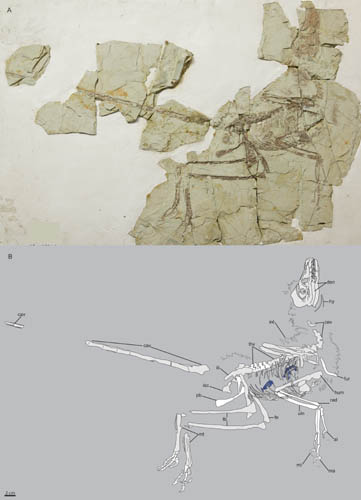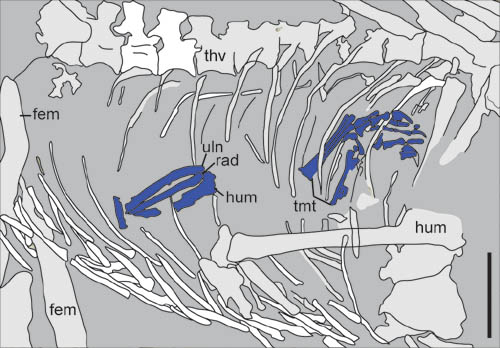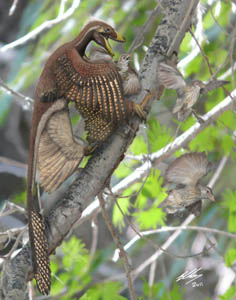New finds from the Jehol Group in northeastern China continue to reveal snapshots of this Early Cretaceous ecosystem through the incredible preservation of soft tissue, stomach contents, and inter- and intraspecific interactions, helping to bring the ancient forest and lakes back to life. The new discovery, a specimen in the collections of the Institute of Vertebrate Paleontology and Paleoanthropology (IVPP), of the Chinese Academy of Sciences, in Beijing, is of a
Microraptor with the partial, articulated remains of an adult enantiornithine bird in its stomach – the first recorded instance of a dinosaur feeding on a bird. “The specimen is also important because of the type of bird that is in the stomach and way it is preserved,” says Dr. Jingmai O’Connor, post-doctoral researcher at the IVPP and first author of the study. “These details provide clues regarding the ecological niche of the predator.”
The evolution of flight is one of the most important debates in Paleontology; until recently, this consisted of a dichotomy between two hypotheses, one which envisioned flight evolving on the ground, from a small cursorial animal (ground up cursorial hypothesis), while the other predicts flight evolved with gravity, in an arboreal environment with a gliding intermediate stage (trees down arboreal hypothesis). New studies on the kinematics of the wing stroke itself suggest that, although earlier hypotheses represent a false dichotomy, the fundamental wing stroke evolved early in maniraptoran dinosaurs (the group that includes birds) and would have been advantageous in either a cursorial or arboreal environment. Therefore, understanding the ecology of dinosaurs closely related to birds is still important for understanding the origin of flight.
Microraptor gui, with aerodynamic flight surfaces on its fore and hind limbs, has been at the center of discussions regarding the evolution of flight among dinosaurs since its initial discovery. However, the ecology of this taxon, whether primarily arboreal or cursorial, is controversial, and the two-dimensional, crushed bones are incapable of answering questions regarding degree of hind limb abduction or posture, which might otherwise provide clues to how the animal was living. However, this new specimen of
Microraptor preserves new evidence to contribute to the debate. The bird preserved in the stomach of this specimen is a member of the clade Enantiornithes; in the Jehol, enantiornithines display arboreal adaptations relative to other avian groups, such as distally located first pedal digit, distal pedal phalanges elongated relative to proximal phalanges, and large recurved pedal claws. Furthermore, the bird is represented by the articulated partial skeleton, suggesting it was not scavenged, in which case you would imagine the specimen to be much more fragmentary and disarticulated, but actively hunted and captured. The ability to hunt and capture an adult bird in an arboreal environment suggests
Microraptor was an agile predator. “Although this new specimen does not mean without a doubt
Microraptor was indeed arboreal or restricted to this environment,” says Dr. O’Connor, “it is suggestive of this hypothesis and contributes new evidence to this important debate.”
Jingmai O'Connor,
Zhonghe Zhou,
Xing Xu. 2011. Additional specimen of
Microraptor provides unique evidence of dinosaurs preying on birds. Proceedings of the National Academy of Sciences.
http://www.pnas.org/content/early/2011/11/17/1117727108.abstractFig. 1. Photograph (A) and camera lucida drawing (B) of the new Microraptor gui specimen IVPP V17972A. (Image by Dr. ZHOU Zhonghe)
Fig. 2. Close up of the abdomen of the new Microraptor; the remains of the enantiornithine bird are indicated by blue.(Image by Dr. ZHOU Zhonghe)
Fig. 3. Reconstruction of the feeding habits of Microraptor. (Image by Brian Choo)









